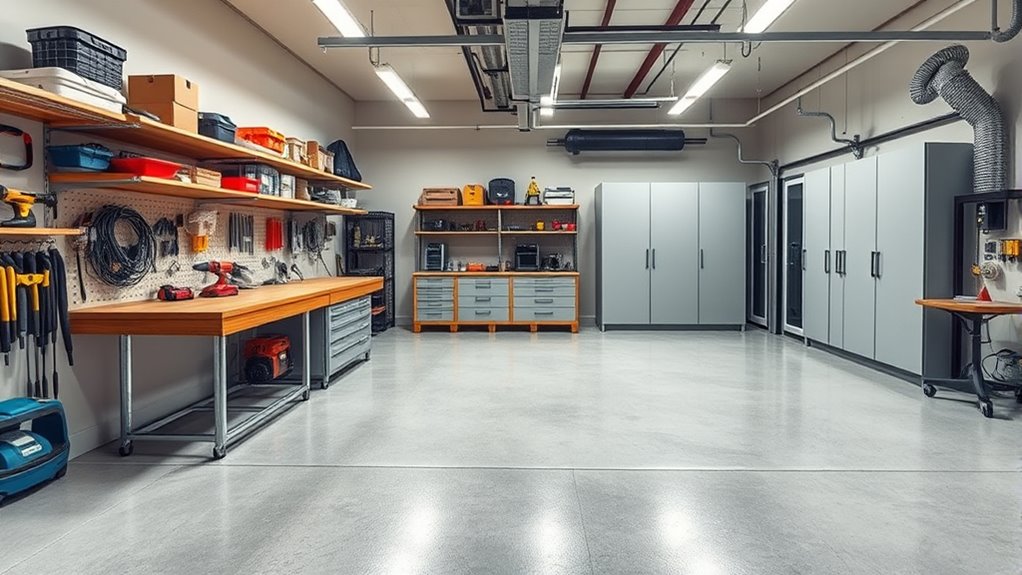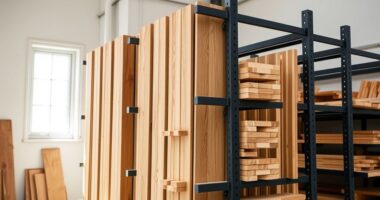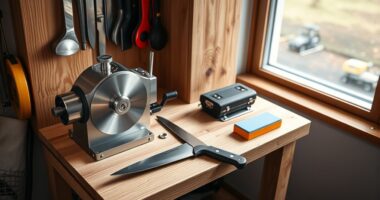To set up a dust-free garage workshop, start by installing high-quality HEPA air purifiers near your work zones and connecting dust collection systems directly to your tools for effective dust capture. Organize your space with shelves, cabinets, and clear pathways, and guarantee proper airflow by placing equipment strategically. Regularly maintain your filtration and cleaning routines to keep dust at bay. Keep going, and you’ll discover all the essential steps to create a safer, cleaner workspace.
Key Takeaways
- Place air purifiers with HEPA filters near work zones to capture airborne dust effectively.
- Connect tools directly to dust collection systems to trap dust at the source.
- Organize the workshop with designated zones and storage to reduce clutter and dust buildup.
- Ensure proper airflow by positioning equipment to direct dust toward filtration units.
- Maintain regular cleaning and equipment checks to sustain optimal dust control and air quality.

Creating a dust-free garage workshop is essential for maintaining a clean, safe, and efficient workspace. When you focus on proper air filtration and workshop organization, you’ll significantly reduce dust buildup and improve air quality, making your projects safer and more enjoyable. The first step is to assess your space and plan how to optimize air filtration. Good air filtration systems are vital because they capture airborne dust particles before they settle on surfaces or get inhaled. You can start with a high-quality air purifier designed for workshops, ensuring it has a HEPA filter that traps tiny dust particles. Position it strategically, ideally near your main work zones, to maximize airflow and dust removal. If your workshop generates a lot of dust regularly, consider installing a dedicated dust collection system connected to your power tools. These systems pull dust at the source, preventing it from dispersing throughout the space. Proper air filtration not only keeps the air cleaner but also reduces the burden on your lungs and keeps your tools functioning optimally by limiting dust accumulation. Additionally, selecting appropriate dust collection equipment tailored for your specific workshop needs can further improve dust management.
Workshop organization plays a crucial role in maintaining a dust-free environment. When your workspace is well-organized, dust has fewer places to settle, and cleaning becomes more manageable. Start by establishing designated zones for tools, materials, and waste. Use wall-mounted shelves, pegboards, and storage cabinets to keep clutter off the floor and surfaces. Clear pathways make sweeping and vacuuming easier, preventing dust from hiding in hard-to-reach corners. Invest in airtight storage containers for powders, sawdust, or other fine particles, so dust doesn’t escape into the air. Regularly clean and wipe down surfaces, tools, and storage units to prevent dust buildup. Incorporate a routine cleaning schedule that includes vacuuming with a HEPA-filter vacuum to pick up fine dust particles effectively. Keeping the workspace organized minimizes dust generation because clutter and disorganized tools tend to trap and hold dust, making cleanup harder.
You also want to pay attention to airflow within your workshop. Good ventilation helps move airborne dust away from your breathing zone and directs it toward filtration units. When planning your workshop layout, position your workbenches, tools, and dust collection systems to promote efficient airflow. Remember, a clean, dust-free garage workshop isn’t achieved overnight; it requires ongoing effort to maintain proper air filtration and workshop organization. By investing in the right equipment and establishing disciplined routines, you’ll create a space that’s safer, healthier, and more productive for all your projects.
Frequently Asked Questions
How Much Does a Dust-Free Garage Workshop Typically Cost to Set Up?
The cost to set up a dust-free garage workshop varies based on your needs, but a typical budget includes a dust collection system, air filtration, and tools. You should do a cost breakdown to identify expenses, aiding with budget planning. Expect to spend between $1,000 and $5,000, depending on quality and size. Investing in good equipment ensures a cleaner, safer workspace, making your investment worthwhile.
What Are the Best Tools for Maintaining Dust Control Long-Term?
To maintain dust control long-term, you should invest in quality air filtration and dust collection tools. Use a high-efficiency air purifier with HEPA filters to continuously clean the air, and set up a reliable dust collection system on your power tools to trap debris at the source. Regularly clean and replace filters, and verify proper system maintenance. These tools keep your garage workshop clean, safe, and dust-free over time.
Can I Retrofit My Existing Garage Into a Dust-Free Workspace?
Turning your garage into a dust-free sanctuary is more achievable than you might think. You can retrofit your space by improving garage ventilation and installing effective dust containment systems. Sealing gaps and adding air filtration units help keep dust at bay, creating a healthier environment. With some strategic upgrades, your existing garage can transform into a clean, efficient workshop that minimizes dust and maximizes your work quality.
How Often Should I Replace or Clean Dust Filtration Systems?
You should check your air filtration system regularly to maintain air quality. Follow a consistent filter replacement schedule—typically every 1 to 3 months, depending on use and dust levels. Keep an eye on signs like reduced airflow or increased dust, which indicate it’s time for cleaning or replacing filters. Proper air filtration maintenance guarantees your workspace stays dust-free and safe, so don’t neglect your filter replacement schedule.
Are There Specific Building Codes or Permits Needed for Dust Control Systems?
You should verify if your local building permits or zoning regulations require approval for installing dust control systems. Many areas mandate permits to ensure safety and compliance with environmental standards. Zoning laws may also specify where such systems can be installed. Contact your local building department or permit office to confirm requirements before you start, preventing potential fines or delays in your garage workshop setup.
Conclusion
Now that you’ve got the essentials down, your garage workshop will be a dust-free sanctuary where your projects thrive. With just a few simple steps, you’ll create a space so clean, it’s practically a cleanroom—your tools and projects will thank you. Keep up with regular maintenance, and you’ll enjoy a workspace that’s almost too pristine to believe. Soon, you’ll be turning out masterpieces in a dust-free paradise that’s as perfect as a sparkling gemstone!









